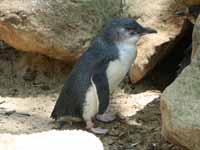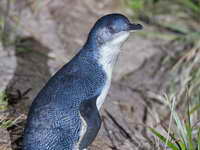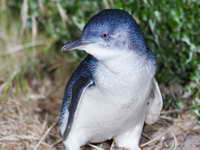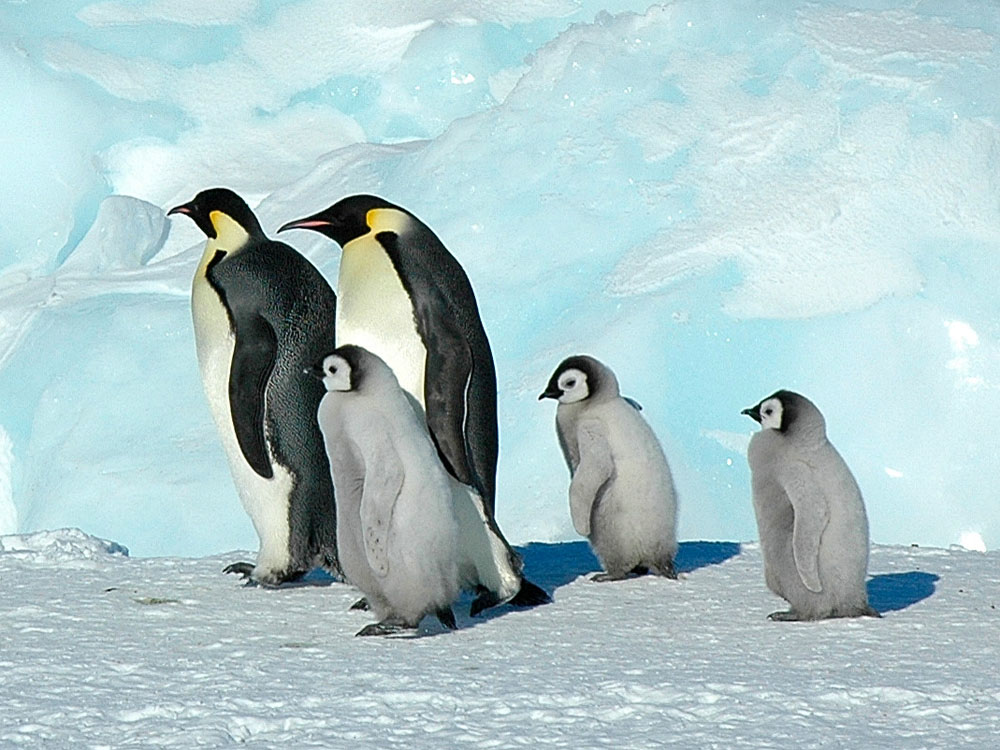Except for cold waters near the Galapagos Islands, penguins are not found in the northern hemisphere. Their bodies are streamlined to minimze resistance underwater. Their rigid flippers, movable at the shoulder, let them "fly" beneath the surface. And like ducks their feet are webbed and are used as rudders. Even though the feet are not well designed for walking, some penguins such as the emperor do manage to travel long distances, but they often slide on their bellies to improve travel efficiency.
Penguins have evolved to be flightlessness as their bodies became better designed for swimming and long stays underwater. Being a good swimmer is not only beneficial for catching fast prey such as fish, agility underwater can also be necessary for escaping from leopard seals, sharks, sea lions, and killer whale. There are threats above water from birds such petrels, skuas and gulls, but the major threats are underwater. There is also the worry of introduced predators such as dogs and even people. Penguins are not well designed to counter these land-based dangers, and survive best if their breeding sites are isolated. Another advantage of giving up the ability of flying is that underwater weight is not a detriment to mobility. Thick layers of fat make it heavier, but help a penguin survive cold Antarctic waters and also provide energy and insulation for the much colder winter air.
Most penguins are colonial nesters, some sites having well over a 100,000 nests! When there is prey such as leopard seals in the vicinity it to the group's benefit for an unlucky penguin fall into the water and graphically demonstrate if these seals are close by. While nesting, some penguin parents take daily shifts with the eggs or chicks, one staying near by while the other goes for food. Other species are away for a week or even months at a time. The length of separation depends on how accessible the nest is to the ocean. The longer it takes to get to the food suppy, the longer the separation has to be.
Penguins lay two eggs, the first considerably smaller than the second. For most species, the first egg is only an insurance policy for successful chick production. If the second egg is laid successfully, the first is rejected and not allowed to further develop. Some penguin species will occasionally successfully raise two chicks, but obtaining the necessary food for the young is stressfull for the parents.
Penguins eat fish, crustaceans such as krill, and also cephalopods such as squid. Many penguins use two different types of dives when foraging, pelagic and benthic dives. Pelagic dives are typically short and relatively shallow and used for shorter periods of time under water. Benthic dives are much steeper and deeper dives to near the seafloor. These dives are used to gather crustaceans at the bottom. But being at the bottom can also aid in the pursuit of fish by removing one of their degrees of freedom - firsh cannot go any lower!
For humans and other freshwater drinking animals, the kidneys are able to remove excess salt. For penguins and other types of birds that drink seawater, the kidneys are not adequate for salt removal. These sea birds have have developed salt glands in the forehead nasal cavities which remove excess salt from the blood and excrete it though the nostrils. The salt glands are designed such that blood flow and salt gland duct flow move in opposite directions. Osmosis causes the salt to leave the higher concentrated blood and transfer to the lower salt density salt gland duct fluid.
Genus Aptenodytes
Penguin,_Emperor Aptenodytes forsteri
Description: The emperor penguin has black upperparts including the head, upper-tail, and feet. It has yellow and white patches behind the ear-coverts. It has a black upper-bill and a pink patch on the under-bill. The underparts are white except for pale yellow on the upper-breast. The emperor penguin is 110 to 120 cm long. Its weight ranges from 20 to 45 kg with the male larger than the female. His weight varies greatly with the season as he spends the winter incubating the pair's egg and during this period he eats nothing, thus losing about 25% of his body weight.
To withstand the frigid temperature the emperor penguin has evolve to have excellent insulating feathers some of which are fine and dense and others which are downy. To cause a thicker insulating layer, the feathers are held erect at a 90 degree angle while on land, but held flat while swimming for waterproofing and lower drag. Another contributing factor to fighting the cold is a layer of fat which is much thicker than that of other birds. This extra weight of course does not bother the penguin as it does not fly. Not only does it provide more insulation, it is a stored energy source which is utilized duing the coldest periods. And just like us, emperor penguins shiver when they are cold as that produces heat by burning energy.
Emperor penguins can dive to amazing depths in their search for food - sometimes over 500 meters. This requires their body to withstand enormous pressure and breath holding of up to 20 minutes!
Range: Antarctica.
Habitat: Around the edges of continent when breeding. They walk and slide up to 100 km to reach their breeding sites.
Diet: Fish, crustaceans and cephalopods such as squid.
Conservation status: It is listed as Near Threatened even though its population is about a half million. It is susceptible to global warming which may reduce the available are of its breeding sites. Also, tourism by helicopters seems to stress the chicks and lessen their survival rate. And overfishing is reducing their food supply.
Image by: 1) Ian_Duffy 2) Samuel Blanc 3) Glenn Grant 4) Christopher_MichelTo withstand the frigid temperature the emperor penguin has evolve to have excellent insulating feathers some of which are fine and dense and others which are downy. To cause a thicker insulating layer, the feathers are held erect at a 90 degree angle while on land, but held flat while swimming for waterproofing and lower drag. Another contributing factor to fighting the cold is a layer of fat which is much thicker than that of other birds. This extra weight of course does not bother the penguin as it does not fly. Not only does it provide more insulation, it is a stored energy source which is utilized duing the coldest periods. And just like us, emperor penguins shiver when they are cold as that produces heat by burning energy.
Emperor penguins can dive to amazing depths in their search for food - sometimes over 500 meters. This requires their body to withstand enormous pressure and breath holding of up to 20 minutes!
Range: Antarctica.
Habitat: Around the edges of continent when breeding. They walk and slide up to 100 km to reach their breeding sites.
Diet: Fish, crustaceans and cephalopods such as squid.
Conservation status: It is listed as Near Threatened even though its population is about a half million. It is susceptible to global warming which may reduce the available are of its breeding sites. Also, tourism by helicopters seems to stress the chicks and lessen their survival rate. And overfishing is reducing their food supply.
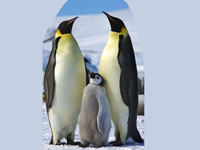
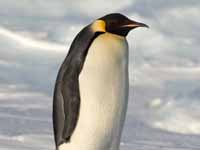
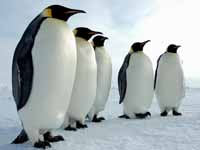
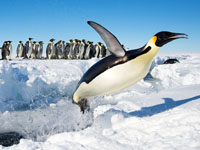
Penguin,_King Aptenodytes patagonicus
Description: The king penguin has grey upperparts including the nape and tail. It has a black head with a bright orange parch behind the ear-coverts. Its bill is longer and straighter that that of an emperor penguin. The upper-bill is black and the lower has a bright orange patch. The underparts are white except for orange on the neck and upper-breast. The king penguin is the second largest penguin species.
They can dive to about about 300 meters and stay submerged for up to 10 minutes which is of course very impressive, but considerably less than what the emperor penguin is capalbe of doing. Both species average considerably shorter stays under water.
Because king penguins breed on islands, they do not have the long walk to breeding grounds that the emperor penguins have. This allows the females and males to share the incubation duties. The incubation method is the same: the eggs are sit on the parents feet and are insulated by feathers hanging over them. The chicks also stay on the parent's feed when then need extra heat.
Range: Sub-Antarctic islands.
Habitat: Antarctica (coast), neighboring islands.
Diet: Fish, cephalopods such as squid, krill.
Conservation status: They are listed as Least Concern with a population of over 2 million. They seem to be increasing in some areas, but decreasing in others as global warming is causing movement of their food sources.
Image by: 1) Liam Quinn 2)
Ben Tubby - West Falkland 3) Anniolek 4) Lin_Padgham They can dive to about about 300 meters and stay submerged for up to 10 minutes which is of course very impressive, but considerably less than what the emperor penguin is capalbe of doing. Both species average considerably shorter stays under water.
Because king penguins breed on islands, they do not have the long walk to breeding grounds that the emperor penguins have. This allows the females and males to share the incubation duties. The incubation method is the same: the eggs are sit on the parents feet and are insulated by feathers hanging over them. The chicks also stay on the parent's feed when then need extra heat.
Range: Sub-Antarctic islands.
Habitat: Antarctica (coast), neighboring islands.
Diet: Fish, cephalopods such as squid, krill.
Conservation status: They are listed as Least Concern with a population of over 2 million. They seem to be increasing in some areas, but decreasing in others as global warming is causing movement of their food sources.
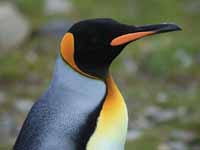
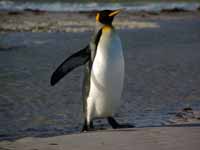
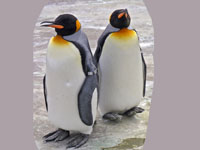

Genus Eudyptes
The 7 crested penguin species have black and white plumage with yellow crests. Most have red eyes and bills. Except for the royal penguin, they all have mainly black heads. They feed on small fish, krill, and squid and breed on Sub-Antarctic islands, many of which are in the vicinity of the South Island of New Zealand. All of the crested penguins lay 2 eggs, but only raise one chick. The first egg is smaller, probably because it develops while the mother is at sea and has less energy available for egg development. Both parents incubate the eggs. Their nearest relative is the yellow-eyed penguin of New Zealand which seperated from the crested penguins about 12 million years ago.
Penguin,_Erect-crested Eudyptes sclateri
Description: The erect-crested penguin has black upperparts including most of the head. A broad, bright yellow eyebrow-stripe extends above the eye to form a short, erect crest. The eyes are red as is the bill which has a grey gape. It has white underparts. The erect-crested penguin is 60 to 70 cm long. This is the largest of the crested penguin. Its closest relative is the Fiordland penguin.
Range: Breeds on Bounty and Antipodes Islands which are south and southeast of the South Island of New Zealand. During nonbreeding seasons they spread out and have even been seen in the Falkland Islands and Australia.
Habitat: They nest on rocky islands in large colonies. Outside of breeding season, they remain at sea for long periods.
Diet: Small fish, krill, squid.
Conservation status: It is listed as Endangered even though there are about 200,000 birds as the breeding range is small.
Image by: 1) John_Barkla 2) Mederic 3) C00chRange: Breeds on Bounty and Antipodes Islands which are south and southeast of the South Island of New Zealand. During nonbreeding seasons they spread out and have even been seen in the Falkland Islands and Australia.
Habitat: They nest on rocky islands in large colonies. Outside of breeding season, they remain at sea for long periods.
Diet: Small fish, krill, squid.
Conservation status: It is listed as Endangered even though there are about 200,000 birds as the breeding range is small.
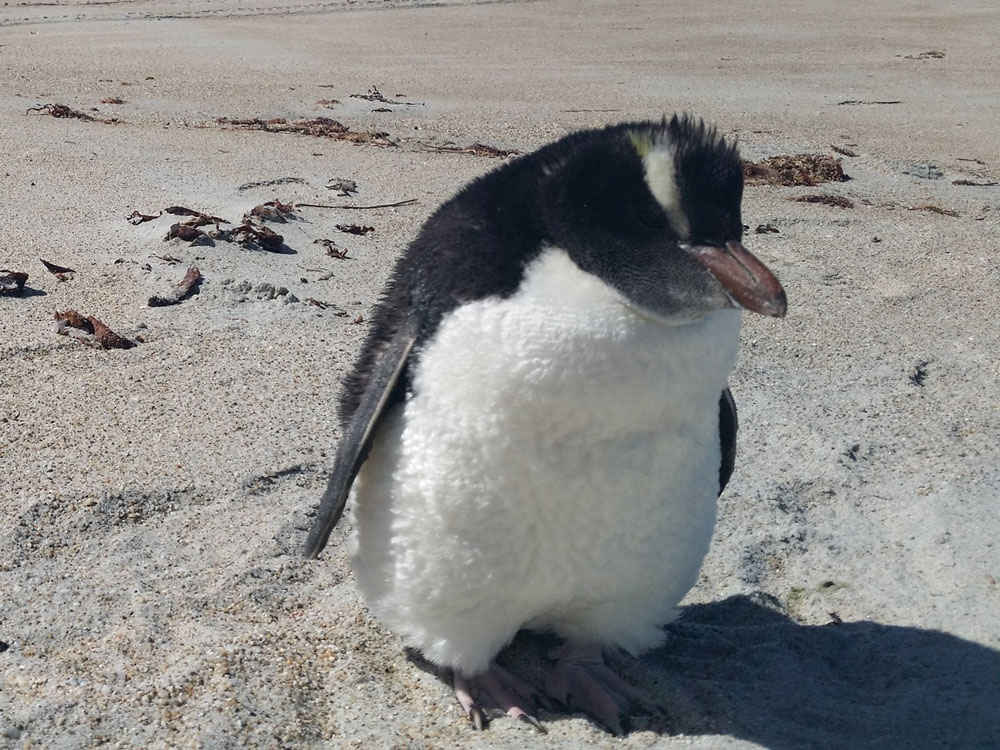
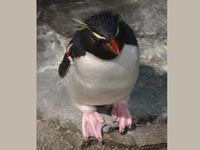
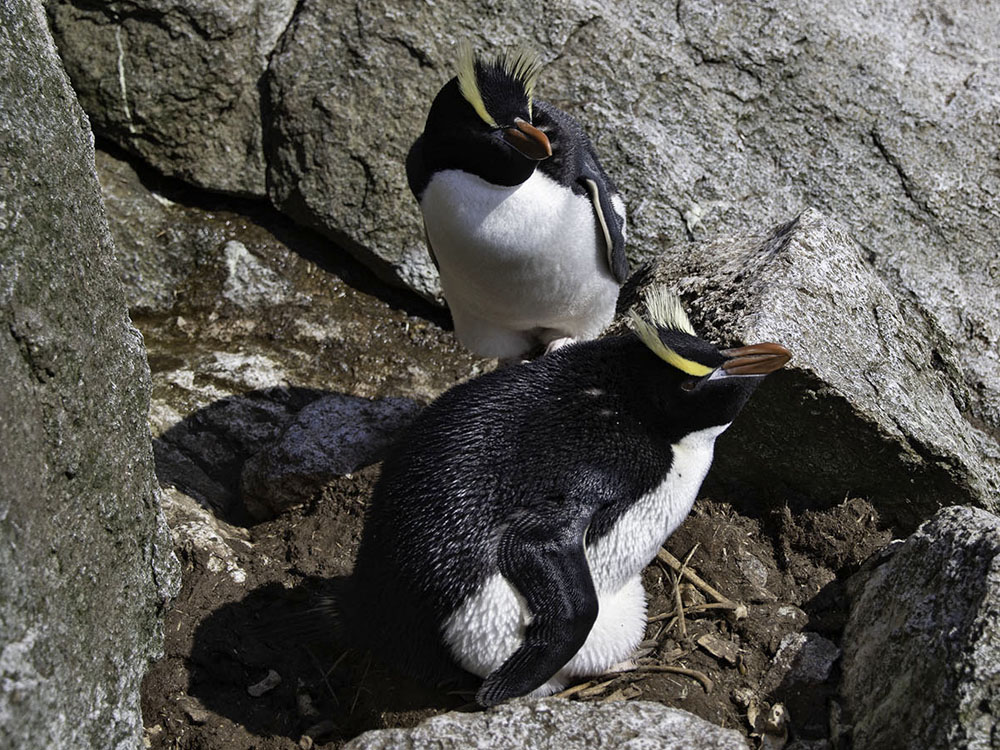
Penguin,_Fiordland Eudyptes pachyrhynchus
Description: The Fiordland penguin has bluish-grey upperparts including most of the head. It has a yellow eyebrow-stripe which extends over the eye and continues down the neck. Most have three to six whitish stripes on the face. The eyes are red as is the bill. It has white underparts. The similar erect-crested penguin is
difficult to differentiate except by range. Also, it does not have white facial stripes.
Range: Breeds in the west coast of the South Island of New Zealand. During nonbreeding season it remains closer to shore than the erect-crested penguin.
Habitat: Nests on beaches along the temperated coastal forest among rocks and tree roots.
Diet: Small fish, krill, squid.
Conservation status: It is listed as Endangered because of a small population. Unlike the erect-crested penguin, it breeds on the shore of the South Islands and suffers greatly from introduced predators such as rats, cats, and dogs.
Image by: 1) P_Khoo 2) Jake_Osborne 3) Francesco_Veronesi - Stewart Islanddifficult to differentiate except by range. Also, it does not have white facial stripes.
Range: Breeds in the west coast of the South Island of New Zealand. During nonbreeding season it remains closer to shore than the erect-crested penguin.
Habitat: Nests on beaches along the temperated coastal forest among rocks and tree roots.
Diet: Small fish, krill, squid.
Conservation status: It is listed as Endangered because of a small population. Unlike the erect-crested penguin, it breeds on the shore of the South Islands and suffers greatly from introduced predators such as rats, cats, and dogs.
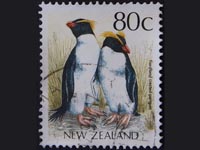
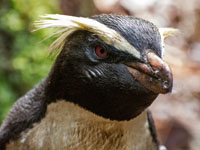
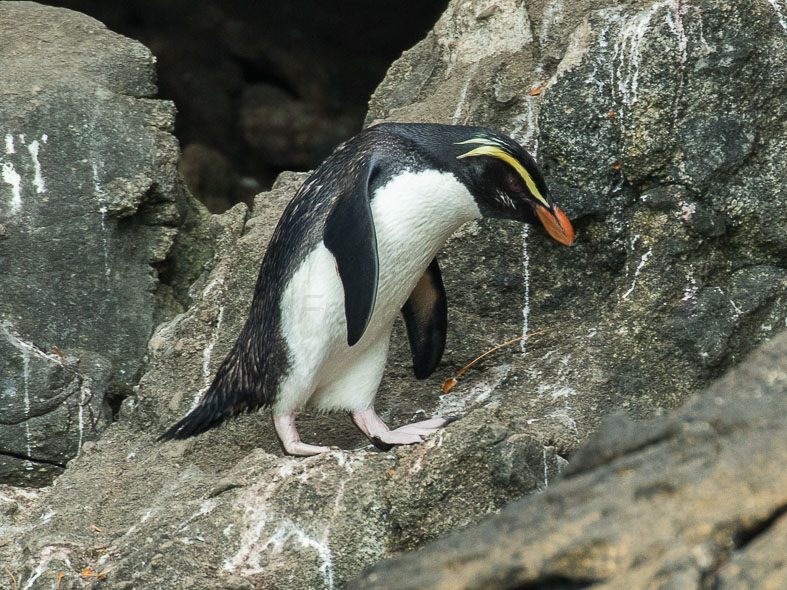
Penguin,_Macaroni Eudyptes chrysolophus
Description:T he macaroni penguin has black upperparts including the most of the head. The eyes are red as is the bill. Its yellow crest is fuller than most of the other crested penguins. In fact its color led and shape to the name "macaroni". It has white underparts. The Macaroni penguin is about 70 cm long. It is closely related to the royal penguin which has a white face.
Three weeks of incubation are divided inot 3 periods. The first session is shared, then just the male incubates as the male returns to the sea for food, and finally the male incubates as the female goes foraging. After hatching the male keeps the chick warm and the female brings it back food every couple of day; then they switch roles.
Range: From the Subantarctic to the Antarctic Peninsula.
Habitat: They breed on islands and then become pelagic and travel for thousands of km.
Diet: Mainly crustaceans, especially krill. Also fish and cephalopods.
Conservation status: It is listed as Vulnerable because of declining populations, That said, there appear to be about 18 million birds and it is the most abundant penguin species. But a population that seems to have been declining steadliy for 30 years is cause for concern.
Image by: 1) Liam_Quinn 2, 3) Jerzy_Strzelecki 4) Andrew_ShivaThree weeks of incubation are divided inot 3 periods. The first session is shared, then just the male incubates as the male returns to the sea for food, and finally the male incubates as the female goes foraging. After hatching the male keeps the chick warm and the female brings it back food every couple of day; then they switch roles.
Range: From the Subantarctic to the Antarctic Peninsula.
Habitat: They breed on islands and then become pelagic and travel for thousands of km.
Diet: Mainly crustaceans, especially krill. Also fish and cephalopods.
Conservation status: It is listed as Vulnerable because of declining populations, That said, there appear to be about 18 million birds and it is the most abundant penguin species. But a population that seems to have been declining steadliy for 30 years is cause for concern.
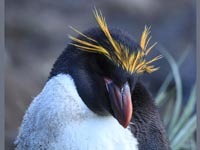
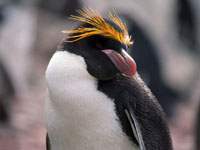

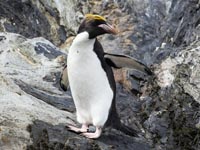
Penguin,_Northern Rockhopper Eudyptes moseleyi
Description: The northern rockhopper penguin, also known as the Moseley's penguin, has black upperparts including most of the head. It has a yellow crest emanating from the supercilium and a black crest on the crown. The eyes are red as is the bill. Underparts are white. The northern rockhopper penguin is 52 to 62 cm long. Both sexes incubate the eggs, taking turns lasting a week or more. The crest of the similar southern rockhopper penguin is much smaller.
Range: The vast majority breed on Tristan da Cunha and Gough Island in the South Atlantic about half way between Africa and South America. A small number breed on St. Paul Island and Amsterdam islands which are in the southern Indian Ocean between Africa and Australia. During nonbreeding seasons, it spends about 6 months at sea.
Habitat: Breed on rocky beaches and also in grassy areas.
Diet: Mainly crustaceans, especially krill. Also fish and cephalopods.
Conservation status: It is listed as Endangered as the population has declinded by 90% in the last 75 years.
Image by: 1, 2, 3) Brian Gratwicke 4) Arjan HaverkampRange: The vast majority breed on Tristan da Cunha and Gough Island in the South Atlantic about half way between Africa and South America. A small number breed on St. Paul Island and Amsterdam islands which are in the southern Indian Ocean between Africa and Australia. During nonbreeding seasons, it spends about 6 months at sea.
Habitat: Breed on rocky beaches and also in grassy areas.
Diet: Mainly crustaceans, especially krill. Also fish and cephalopods.
Conservation status: It is listed as Endangered as the population has declinded by 90% in the last 75 years.
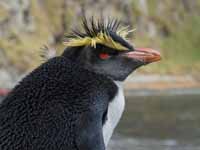


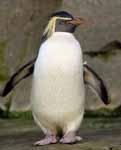
Penguin,_Royal Eudyptes schlegeli
Description: The royal penguin has black upperparts including the most of the head. The bill is orange and there is a thin edging of pink skin around its base. There is a yellow crest on each side of the head with some black feather also present in the crest. It has white underparts. The royal penguin is about 75 cm long. It is closely related to the macaroni penguin which has a black face.
Range: Breed only on Macquarie Island (halfway between New Zealand and Antarctica) and are assumed to be pelagic at other times,
Habitat: The breeding island has rocky shores with some tufts of grass mixed in.
Diet: Mainly crustaceans, especially krill. Also fish and cephalopods.
Conservation status: It is listed as Near Threatened. About a hundred years ago 100,000 royal penguins per year used to be harvested for their oil. Since that slaughter has stopped their nmbers have rebounded to about 1 million.
Image by: 1, 2) M. Murphy 3, 4) Natalie_TapsonRange: Breed only on Macquarie Island (halfway between New Zealand and Antarctica) and are assumed to be pelagic at other times,
Habitat: The breeding island has rocky shores with some tufts of grass mixed in.
Diet: Mainly crustaceans, especially krill. Also fish and cephalopods.
Conservation status: It is listed as Near Threatened. About a hundred years ago 100,000 royal penguins per year used to be harvested for their oil. Since that slaughter has stopped their nmbers have rebounded to about 1 million.
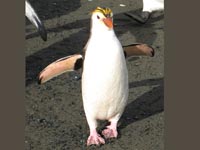
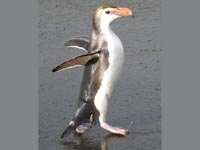
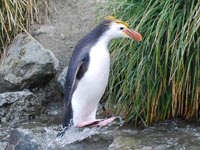

Penguin,_Snare's Eudyptes robustus
Description: The Snare's penguin has black upperparts including most of the head. The eyes are red. The reddish-brown bill has pink skin at its base and there is yellowish crest beginning at base of bill which extends to the rear of the head. It has white underparts. The Snare's penguin is 55 to 70 cm long. The similar Fiordland penguin does not have pink skin at the base of its bill.
Range: Breeds on The Snares - islands off New Zealand. Pelagic at other times of the year.
Habitat: Nest in dense colonies under tree cover. Breeding sites are reused until the site becomes muddy from lack of vegetation.
Diet: Mainly cephalopods such as squid, also fish and crustaceans.
Conservation status: It is listed as Vulnerable because of its limited breeding range, but the populations seems to be stable at about 25000.
Image by: 1) Thomas Mattern - Snare's Islands 2) Ted_van_den_Bergh 3) lin_padghamRange: Breeds on The Snares - islands off New Zealand. Pelagic at other times of the year.
Habitat: Nest in dense colonies under tree cover. Breeding sites are reused until the site becomes muddy from lack of vegetation.
Diet: Mainly cephalopods such as squid, also fish and crustaceans.
Conservation status: It is listed as Vulnerable because of its limited breeding range, but the populations seems to be stable at about 25000.
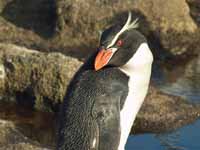
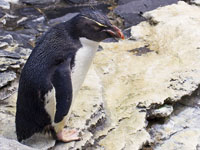
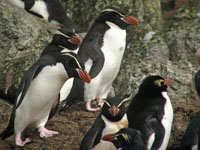
Penguin,_Southern Rockhopper Eudyptes chrysocome
Description: The southern rockhopper penguin has slate-grey upperparts including the most of the head. It has yellow eye-brows ending in long yellowish plumes. The eyes are red as is the bill. It has white underparts. The southern rockhopper penguin is 45 to 58 cm long which makes it the smallest of the crested penguins. The similar northern rockhopper has more substantial crests than the southern rockhopper.
Range: Most breed on the Falkland Islands, and islands off Argentina and southern Chile. Some also breed on islands in the southern Indian Ocean and islands south of New Zealand.
Habitat: It mainly nests on rock shores of islands. At other times they are pelagic and remain at sea for months at a time.
Diet: Mainly crustaceans, especially krill. Also fish and cephalopods.
Conservation status: There is a population of around a million, but it is listed as Vulnerable because the population is slowly declining.
Image by: 1) Samuel Blanc 2) Stan_Shebs 3) Liam_Quinn 4) Nik_BorrowRange: Most breed on the Falkland Islands, and islands off Argentina and southern Chile. Some also breed on islands in the southern Indian Ocean and islands south of New Zealand.
Habitat: It mainly nests on rock shores of islands. At other times they are pelagic and remain at sea for months at a time.
Diet: Mainly crustaceans, especially krill. Also fish and cephalopods.
Conservation status: There is a population of around a million, but it is listed as Vulnerable because the population is slowly declining.
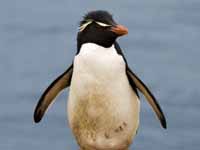

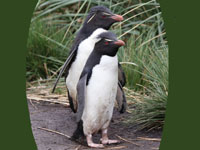
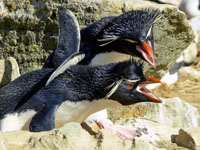
Genus Megadyptes - 1 species
Penguin,_Yellow-eyed Megadyptes antipodes
Description: The yellow-eyed penguin has bluish-black upperparts. The head is yellowish with a halo-like yellow ring from eye to eye. It also has yellow eye-rings. The yellow-eyed penguin is 65 to 76 cm long, While incubating and first feeding chicks, one parent will forage for the day while the other will babysit. After the chicks are six weeks old then both parents will leave the chicks for the day. They are not colonial nesters. The closest relatives are the crested penguins of genus Eudyptes.
Range: New Zealand (southern) and the environs
Habitat: Breeds near the shore in areas protected by dense vegetation. Usually forages within a 100 km of shore.
Diet: Mainly fish; also cephalopods, crustaceans, Perhaps they eat jellyfish, but they might be just catching small fish that are nibbling on the jellyfish. They are mainly benthic feeders, foraging close to the bottom.
Conservation status: It is listed as Endangered with a population of around 4000 because of introduced predators and also habitat degradation. They do no reproduce in zoos.
Image by:1) Ville Miettinen 2) Christian
Mehlführer 3) Bernard_Spragg - Dunedin, New Zealand 4) Katja_Schulz - South IslandRange: New Zealand (southern) and the environs
Habitat: Breeds near the shore in areas protected by dense vegetation. Usually forages within a 100 km of shore.
Diet: Mainly fish; also cephalopods, crustaceans, Perhaps they eat jellyfish, but they might be just catching small fish that are nibbling on the jellyfish. They are mainly benthic feeders, foraging close to the bottom.
Conservation status: It is listed as Endangered with a population of around 4000 because of introduced predators and also habitat degradation. They do no reproduce in zoos.
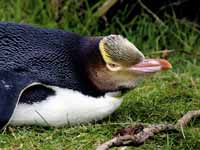
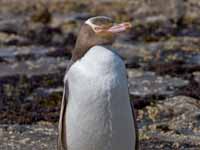
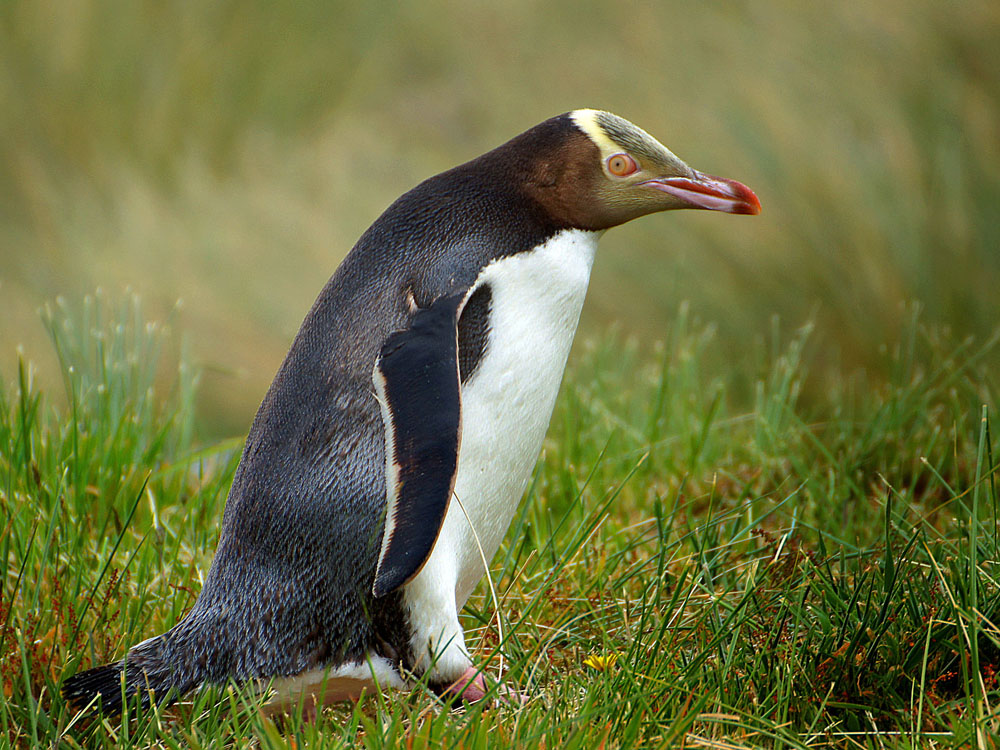

Genus Pygoscelis
Penguin,_Adelie Pygoscelis adeliae
Description: The Adelie penguin has black upperparts. It has a white eye-ring. white feathers at base of its small red and black bill, and white underparts. The Adelie penguin is about 70 cm long. The have many breeding colonies around the edge of Antarctica, some over 100,000 birds.
Range: Antarctica (coast), neighboring islands.
Habitat: As the sea ice expands further from the mainland, the penguins move away from the continent and thus get more daylight!.
Diet: Krill, fish; also squid, jellyfish.
Conservation status: Least Concern.
Image by: 1) Claudio_Timm 2) Dr. Wayne Trivelpiece 2) Jason Auch 3) Andrew_Shiva 4) Liam_QuinnRange: Antarctica (coast), neighboring islands.
Habitat: As the sea ice expands further from the mainland, the penguins move away from the continent and thus get more daylight!.
Diet: Krill, fish; also squid, jellyfish.
Conservation status: Least Concern.
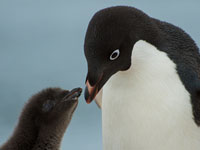

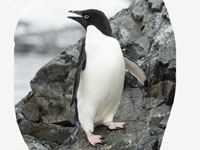
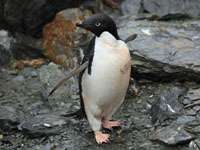
Penguin,_Chinstrap Pygoscelis antarcticus
Description: The chinstrap penguin has black upperparts. It has a black crown. The white on its face extends well behind the eyes;. The "chinstrap" is a thin black line that goes from near the back of the head, under the chin, and around to the other side of the head. The underparts are white, the bill is black, and the feet are pink. The chinstrap penguin is 65 6o 75 cm long. They are probably the most aggressive and ill-tempered species of penguin
Range: Breeds on sub-Antarctic rocky islands around the continent. Most breeding colonies are found in the South Atlantic.
Habitat: They nest on rocky islands that are ice free so that small rocks can be made to form a nest site.
Diet: Mainly krill. Also other crustaceans and fish.
Conservation status: Least Concern.
Image by: 1) Gilad Rom 2) Jason
Auch 3) David_Cook - South Shetland Islands 4) Ravas51 - South Shetland IslandsRange: Breeds on sub-Antarctic rocky islands around the continent. Most breeding colonies are found in the South Atlantic.
Habitat: They nest on rocky islands that are ice free so that small rocks can be made to form a nest site.
Diet: Mainly krill. Also other crustaceans and fish.
Conservation status: Least Concern.
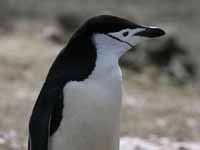
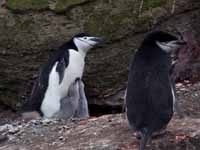
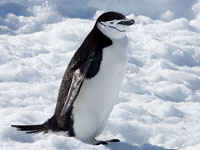
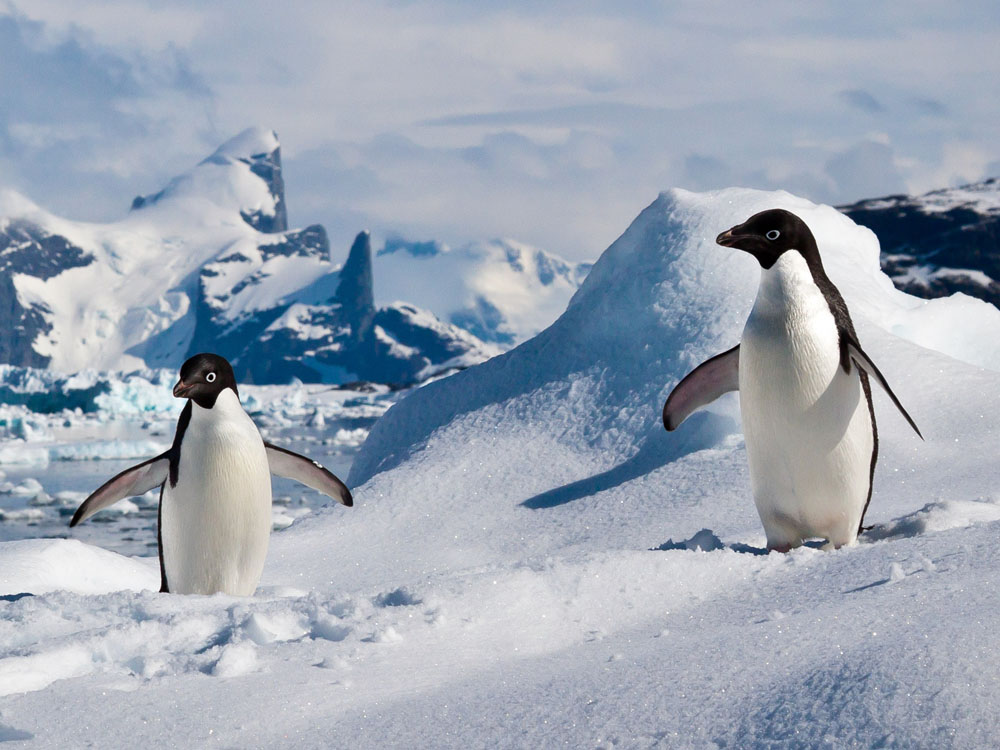
Penguin,_Gentoo Pygoscelis papua
Description: The gentoo penguin has black upperparts. It has a black head with a wide white patch that goes from eye to eye. The bill is orange-red bill, the feet are whitish-pink, and the tail is long for a penguin. The gentoo penguin is 75 to 80 cm long. They are supposedly the fastest of all the penguins. Unlike most penguin species, the pairs switch incubation duties on a daily basis.
Range: From the southern tip of South America to Antarctica. The breed on many subantarctic islands, favoring the Falkland Islands, South Georgia and the South Sandwich Islands, and Kerguelen Islands. While not breeding they head north, even reaching as far north as Buenos, Argentina.
Habitat: Flat rocky coasts for breeding. They usually feed within 10 km of shore.
Diet: Mainly krill and other crustaceans; also fish.
Conservation status: Least Concern.
Image by: 1) Zee
Evans
2) Jerzy Strzelecki 3) Charlie Westerinen - Port Lockroy. Antarctica 4) Andrew_Shiva - Tabarin Peninsula Liam_QuinnRange: From the southern tip of South America to Antarctica. The breed on many subantarctic islands, favoring the Falkland Islands, South Georgia and the South Sandwich Islands, and Kerguelen Islands. While not breeding they head north, even reaching as far north as Buenos, Argentina.
Habitat: Flat rocky coasts for breeding. They usually feed within 10 km of shore.
Diet: Mainly krill and other crustaceans; also fish.
Conservation status: Least Concern.
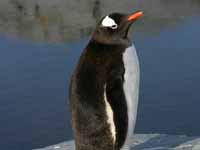
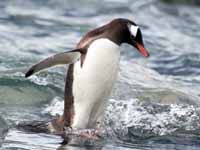
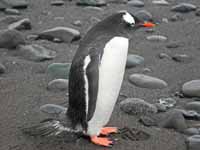
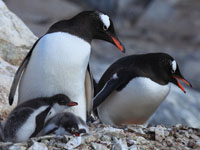
Genus Spheniscus
These species are sometimes called "double band" as many of then have two breast-bands.
Penguin,_African Spheniscus demersus
Description: The African penguin, also known as the jackass penguin for its braying call, has black upperparts. It has a black crown, black nape and a wide white stripe behind a black mask. The mostly white underparts have a black breast-band that extends along the flanks. There also are some small black spots on the breast. The African penguin is 60 to 70 cm long.
Range: The coasts of Namibia and South Africa.
Habitat: The breeding colonies are mainly on off-shore islands for protection against predators. The photos below were taken at an inland colony on Bolders Beach, Cape Town.
Diet: Sardines, anchovies, krill, shirmp, squid.
Conservation status: It is listed as Endangered as is population of 50,000 is declining. One reason is that commerical fishing is reducing the supply of sardines and anchovy. African penguins do well in zoos as they do not require cold temperatures, so in the worst case that could insure captive survival of the species.
Image by: 1, 2, 3, 4) Dick Daniels - South Africa Range: The coasts of Namibia and South Africa.
Habitat: The breeding colonies are mainly on off-shore islands for protection against predators. The photos below were taken at an inland colony on Bolders Beach, Cape Town.
Diet: Sardines, anchovies, krill, shirmp, squid.
Conservation status: It is listed as Endangered as is population of 50,000 is declining. One reason is that commerical fishing is reducing the supply of sardines and anchovy. African penguins do well in zoos as they do not require cold temperatures, so in the worst case that could insure captive survival of the species.
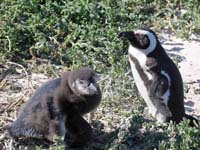
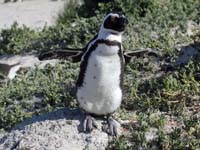

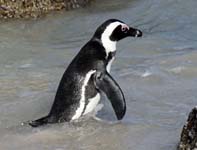
Penguin,_Galapagos Spheniscus mendiculus
Description: The Galapagos penguin has black-grey upperparts, whitish underparts, and two black breast-bands on its blotchy chest. It is one of the smallest penguins with a length of 50 cm. If it is in the warm sun, it will bend over so the feet are shaded as the feet have less insulation and a good blood supply which helps to cool the rest of the body. Their nests are located in caves and creviices so that the eggs are shaded.
Range: Galapagos Islands, Fernandina Island, and Isabela Island. It is the only penguin species found north of the Ecuador. It can survive there because of cold ocean currents.
Habitat: The rocky islands and seas relatively close by.
Diet: Mainly small fish. The penguins will attack a school of fish from the bottom so they are trapped against the surface. This feeding behavior is also beneficial for birds that are in the area.
Conservation status: It is listed as Endangered because of its limited range which means an adverse weather event can play havoc with the population.
Image by: 1) putneymark 2) Richard
Jenkinson 3) Charles_J_Sharp 4) David_CookRange: Galapagos Islands, Fernandina Island, and Isabela Island. It is the only penguin species found north of the Ecuador. It can survive there because of cold ocean currents.
Habitat: The rocky islands and seas relatively close by.
Diet: Mainly small fish. The penguins will attack a school of fish from the bottom so they are trapped against the surface. This feeding behavior is also beneficial for birds that are in the area.
Conservation status: It is listed as Endangered because of its limited range which means an adverse weather event can play havoc with the population.
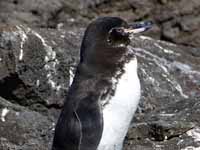
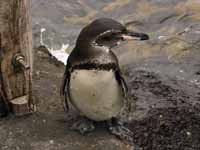
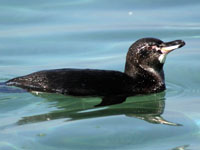
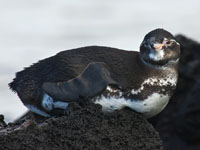
Penguin,_Humboldt Spheniscus humboldti
Description: The Humboldt penguin has black upperparts. It has a black head with a white supercilium that extends in arc to the breast. It was white eye-rings and a mainly black bill.
There are two black breast bands; the lower extends to the flanks. The rest of the underparts are white except for some black spots. The Magellanic and Humboldt penguins look very similar and their ranges do overlap. Only the Humboldt has white lores. It also has some black spots on the underparts while the Magellanic penguin has few if any spots.
Range: Pacific coast of South America from Peru to Chile where the Humboldt Current exits.
Habitat: Breeds on islands and rocky coastlines. Has its nest in rock caves or caves hollowed from guano.
Diet: The Humboldt Current is rich in nutrients and therefore fish, cephalopods, and crustaceans which are favorite foods of this penguin.
Conservation status: It is listed as Vulnerable as guano removal has made their nesting sites less optimal. Also, El Nino makes the ocean warmer than usually which can cause the penguins food supply to deviate from where the penguins are used to being located.
Image by: 1) Wilfried
Wittkowsky 2) Pelican - Asahiyama zoo, Asahikawa, Japan 3, 4) Dick Daniels - Woodland Park Zoo, SeattleRange: Pacific coast of South America from Peru to Chile where the Humboldt Current exits.
Habitat: Breeds on islands and rocky coastlines. Has its nest in rock caves or caves hollowed from guano.
Diet: The Humboldt Current is rich in nutrients and therefore fish, cephalopods, and crustaceans which are favorite foods of this penguin.
Conservation status: It is listed as Vulnerable as guano removal has made their nesting sites less optimal. Also, El Nino makes the ocean warmer than usually which can cause the penguins food supply to deviate from where the penguins are used to being located.
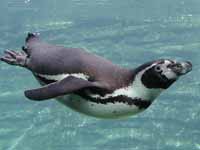
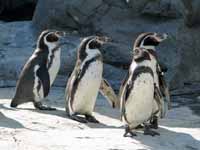
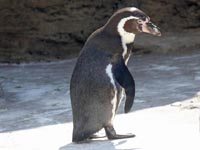
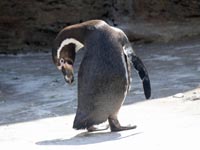
Penguin,_Magellanic Spheniscus magellanicus
Description: The Magellanic penguin has black upperparts. It has a black head with a broad white border, white eye-rings, and a black and white bill. There are two black breast bands; the lower extends to the flanks, The rest of the underparts are white rest. The Magellanic penguin is 70 to 75 cm long. The nests are created in burrows or under bushes. The Magellanic and Humboldt penguins look very similar and their ranges do overlap. Only the Humboldt penguin has white lores. It also has some black spots on the underparts while the Magellanic penguin has few if any spots.
Range: Main breeding sites on the Pacific coast of South America in Argentina, Chile, and the Falkland Islands. Also found on the Atlantic coast of Brazil and Uruguay. Also south Australia and New Zealand.
Habitat: Nest sites on beaches or forests close to the shore then migrate north during the winter and become more pelagic.
Diet: Mainly fish, also cephalopods, crustaceans, jellyfish.
Conservation status: Least Concern.
Image by: 1, 2)
dFaulder - Argentina 3) Guglielmo Celata - Chile 4) Linda_De_Volder - PatragoniaRange: Main breeding sites on the Pacific coast of South America in Argentina, Chile, and the Falkland Islands. Also found on the Atlantic coast of Brazil and Uruguay. Also south Australia and New Zealand.
Habitat: Nest sites on beaches or forests close to the shore then migrate north during the winter and become more pelagic.
Diet: Mainly fish, also cephalopods, crustaceans, jellyfish.
Conservation status: Least Concern.
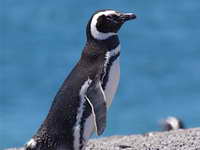
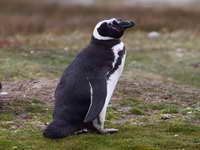
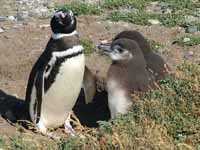
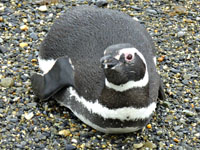
Genus Eudyptula - 1 species
Penguin,_Little Blue Eudyptula minor
Description: The little blue penguin, also known as the little penguin, has blue upperparts. It has paler grey ear-coverts and forehead, a dark grey-black bill. and pink feet. The underparts are white. At a length of about 45 cm the little blue penguin is the smallest of the penguins, When there are eggs to incubate of chicks to feed, one of the pair leaves land around sunrise to hunt for food and returns close to dark.
Range: Mainly breeds on Australian islands where it is protected from predators; also some colonies in New Zealand.
Habitat: Nests can be a distance inland from shore, up to 500 km. They mainly feed with 100 km of land.
Diet: Fish, cephalopods, crustaceans; perhaps also jellyfish.
Conservation status: Least Concern.
Image by: 1, 2) Dick Daniels - the Antarctic Center in NZ 3, 4) JJ Harrison - Tasmania, AustraliaRange: Mainly breeds on Australian islands where it is protected from predators; also some colonies in New Zealand.
Habitat: Nests can be a distance inland from shore, up to 500 km. They mainly feed with 100 km of land.
Diet: Fish, cephalopods, crustaceans; perhaps also jellyfish.
Conservation status: Least Concern.
